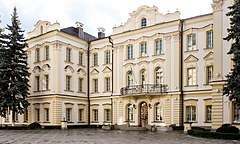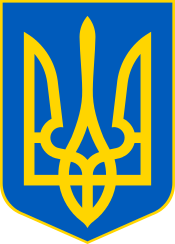Supreme Court of Ukraine
The Supreme Court of Ukraine (Ukrainian: Верховний Суд України, Verkhovny Sud Ukrayiny) is the highest judicial body in the system of courts of general jurisdiction in Ukraine.[1]
| Supreme Court of Ukraine Верховний Суд України | |
|---|---|
 | |
| Established | December 15, 1917 |
| Location | Klov Palace, Kiev |
| Composition method | Presidential-parliamentary appointment |
| Authorized by | Constitution of Ukraine |
| Appeals to | Constitutional Court (constitutional matters) |
| Judge term length | 5-year term, renewable |
| Website | www.scourt.gov.ua |
| Head | |
| Currently | Valentyna Danishevska |
| Since | 30 November 2017 |
| First Vice President | |
 |
|---|
| This article is part of a series on the politics and government of Ukraine |
|
Presidency
|
|
Executive |
|
|
|
The Court derives its authority from the Constitution of Ukraine, but much of its structure is outlined in legislation. More detailed description of the Court's functions and authority may be found in the Law of Ukraine "On the Judiciary and the Status of Judges".
Structure
The Court consists of several judicial chambers (on criminal, civil, administrative, and arbitration (commercial) cases and the Grand Chamber of the Supreme Court).[1] According to a judicial reform the Court consists of 48 justices.
Appointments to the Court are made after selected in a competition candidates are vetted by the Supreme Council of Justice, who then draw up a final list of candidates for the Supreme Court.[1] After a relevant presidential decree, these candidates will become judges of the Supreme Court.[1] Each member of the Court (as far as each judge in Ukraine) is obligated to retire at the age of 65.
The Chairman of the Supreme Court is elected to office and dismissed from office by the Plenary Assembly of the Court by secret ballot.[2]
In July 2010 functions of the Court was severely limited.[3] But in November 2011 the functions of Supreme Court were broadened; its number of judges became 48.[4]
History
The first Supreme Court of Ukraine was established on December 15, 1917 as the General Court of the Ukrainian People's Republic. It was the first established national court since liquidation of Hetmanate in the 18th century. Soon after that on January 17, 1918 the Communist government of Ukraine People's Secretariat declared about creation of the People's Court of Ukraine.
The General Court consisted of 15 judges that were elected by the Central Council of Ukraine on proposition of the General Secretariat of Ukraine. The competence of the elected judges was extended until the adoption of the Constitution of Ukraine by the All-Ukrainian Constituent Assembly. Office of Prosecutor was established within the General Court and headed by the Senior Prosecutor who was appointed by the Secretary of Court Affairs (Minister of Justice).
The first judges to the court were elected on January 15, 1918 among which were M. Pukhtynsky, P. Achkasov, O. Butovsky, F. Popov, M. Radchenko, O. Khrutsky, S. Shelukhin, and H. Shyianov and later were joined by P. Yatsenko, M. Vasylenko, K. Tovkach, A. Margolin, M. Cherniavsky, B. Kistiakivsky, I. Kistiakivsky. The Senior Prosecutor was appointed Dmytro Markovych.
On July 8, 1918, the Hetman of Ukraine completely changed the upper echelon of judicial jurisdiction in the country.
The court in the Soviet Ukraine was established on March 11, 1923. It moved into the 18th-century Klov Palace in 2003.
According to a 2009 poll, the overall trust in the Court in Ukraine is very low.[5]
In the judicial reform introduced in 2016 the following three courts were abolished and its tasks transferred to special chambers of the Supreme Court of Ukraine.[6]
- The High Specialized Court on Civil and Criminal Cases, covering civil and criminal cases;
- The High Administrative Court of Ukraine, covering administrative cases;
- The High Commercial Court of Ukraine, covering commercial cases.
Heads
Soviet period
| Name | Term of office | Notes |
|---|---|---|
| Serhiy Buzdalin | 1923–1924 | |
| Mykhailo Lebedynets | 1924– | |
| Mykhailo Mykhailyk | 1925–1926 | |
| Frants Mazur | 1926–1928 | |
| Semen Krupko | 1928–1929 | |
| Herman Zavitskyi | 1929–1934 | |
| Hryhoriy Zhelieznohorskyi | 1934–1936 | |
| Fedir Shumyatskyi | 1936–1938 | |
| Kostiantyn Topchiy | 1938–1948 | |
| Petro Noshchenko | 1948–1957 | |
| Fedir Hlukh | 1957–1963 | |
| Volodymyr Zaichuk | 1963–1970 | |
| Oleksandr Yakymenko | 1970–1991 |
Independent period
| Name[7] | Term of office | Length of term |
|---|---|---|
| Oleksandr Yakymenko | 1991–1993 | 2 years, 53 days |
| Heorhiy Butenko | 1993–1994 | 342 days |
| Vitaliy Boiko | 1994–2002 | 7 years, 307 days |
| Vasyl Malyarenko | 2002–2006 | 3 years, 252 days |
| Vasyl Onopenko | 2006–2011 | 4 years, 362 days |
| Petro Pylypchuk | 2011–2013 | 1 year, 116 days |
| Yaroslav Romanyuk | 2013–2017 | 4 years, 177 days |
| Valentyna Danishevska | 2017–present | 2 years, 259 days |
Sources and references
- U.S. Embassy: Integrity concerns of Ukraine Supreme Court nominees remain, UNIAN (31 July 2017)
- Petro Pylypchuk elected head of Supreme Court of Ukraine, Kyiv Post (23 December 2011)
- Ukraine’s Opposition Program Requires Another Revolution, The Jamestown Foundation (29 May 2012)
- Yanukovych signs law that broaden functions of Supreme Court, Kyiv Post (11 November 2011)
- Poll: Citizens have low level of confidence in CEC and Supreme Administrative Court, Kyiv Post (December 28, 2009)
- Amendments to the Constitution of Ukraine passed: Ukraine takes a major step towards a European System of Justice, Lexology (9 June 2016)
Poroshenko signs law on High Council of Justice, Interfax-Ukraine (3 January 2017)
New Supreme Court launches work in Ukraine, 3 new codes put into force, UNIAN (15 December 2017) - http://dovidka.com.ua/user/?code=239423
External links
- "Information web-site of the Supreme Court" (in Ukrainian). Retrieved 2006-07-04.
- "The High Arbitration Court of Ukraine (official site)". Archived from the original on 2006-05-15. Retrieved 2006-07-04.
- (in Ukrainian) Law of Ukraine "On the Judiciary and the Status of Judges", as amended
- General Court of Ukraine. Jurist Dictionary - Handbook.
- Government of Ukraine – court overview